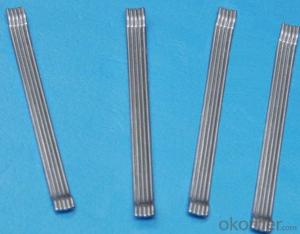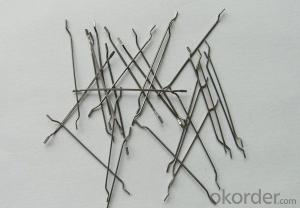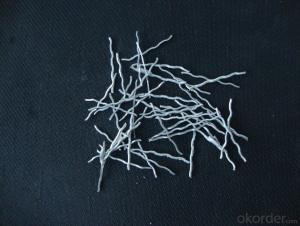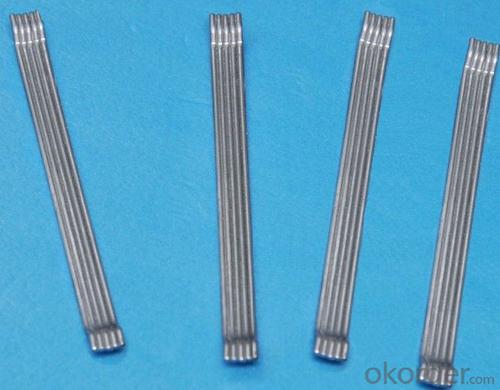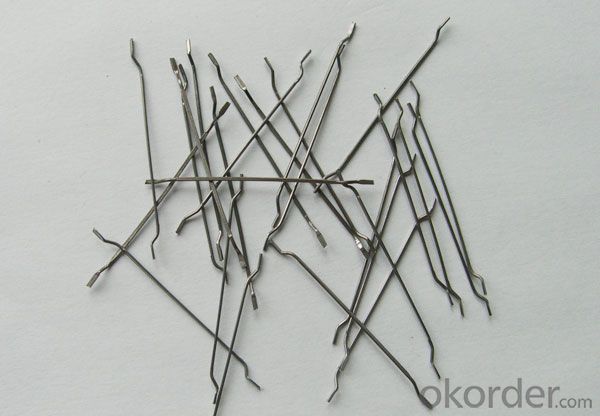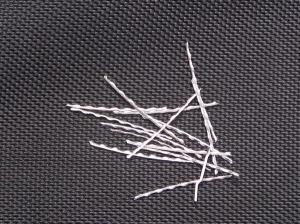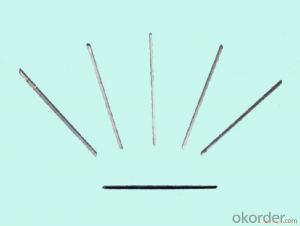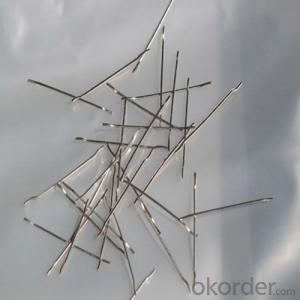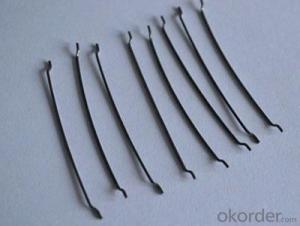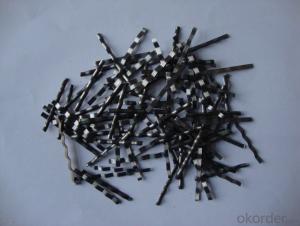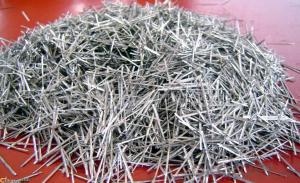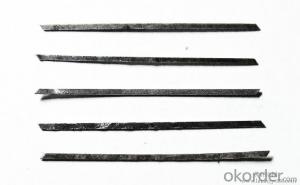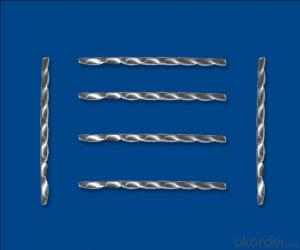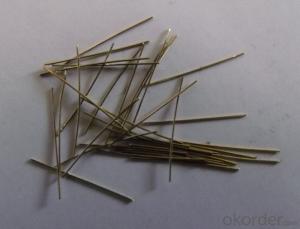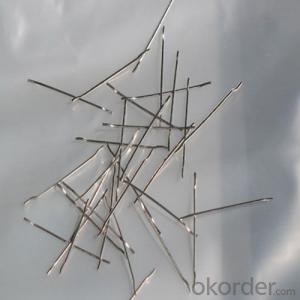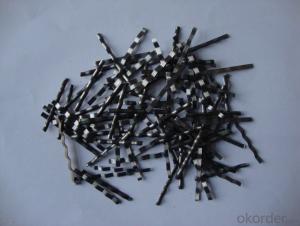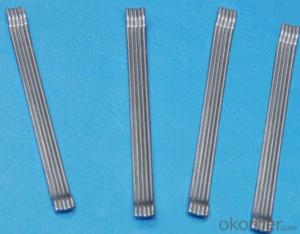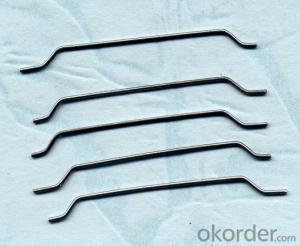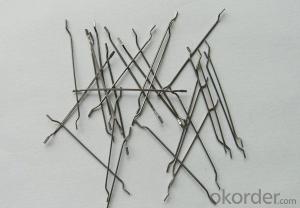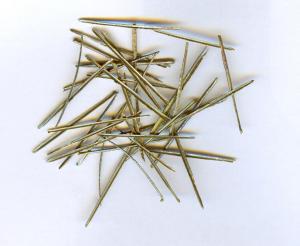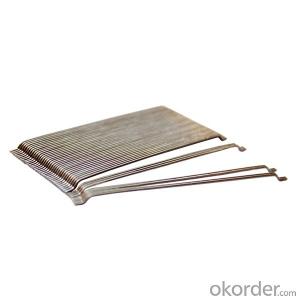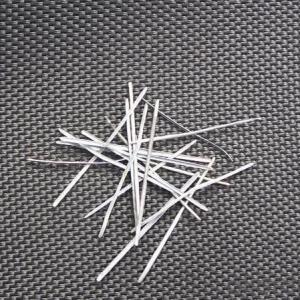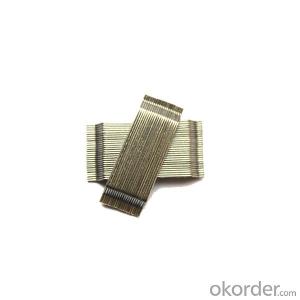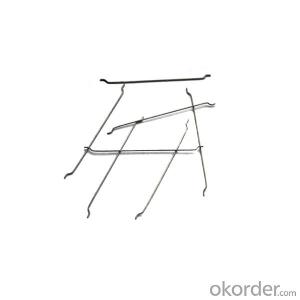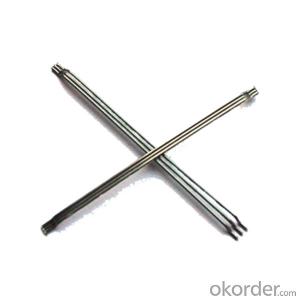Melt Extract Stainless Steel Fiber Straight Type CNBM from China
- Loading Port:
- Tianjin
- Payment Terms:
- TT OR LC
- Min Order Qty:
- 1000 kg
- Supply Capability:
- 30000 kg/month
OKorder Service Pledge
OKorder Financial Service
You Might Also Like
Quick Details
Place of Origin: Jiangsu, China (Mainland)
Model Number: HT-ST
Material: Steel
Specifications
Steel fibers today offer the designer and constructer state-of-the-art technology for use as reinforcement in many concrete elements and applications. There are many varieties of styles, shapes and sizes of steel fibers in the market today.
Introducing steel fibers into the concrete mix provide new mechanical properties. We now have a new material, with improved mechanical properties that can enhance structural applications. The fibers can be included as a substitute for the common steel reinforcement, or as a complement, or for a better performance for strain that the common reinforcement can't absorb.
In mechanical and performance terms, by adding steel fibers to the concrete mix you can:
Increase and get a stable of tensile strength under flexion load, which produces a ductile behavior
Increase impact resistance
Increase cyclic loads of resistance (fatigue effect)
Increase prevention of the plastic shrinkage crack
Increase the concrete performance against thermal variations
Get minor permeability
Picture
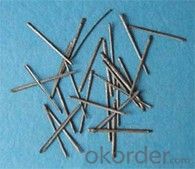
Steel fiber straight type
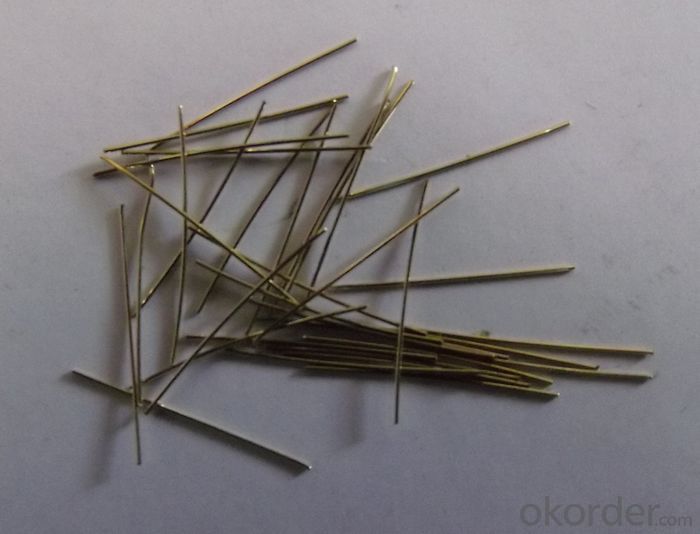
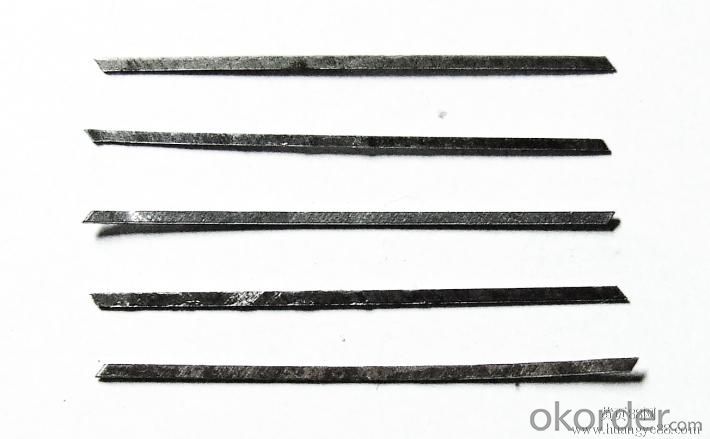
FAQ
certificated: ISO 9001
Technical advantages of Daye steel fiber:
A. Improve mechanical performance of concrete
B. Provide uniform distribution throughout concrete with excellent mixing
C. No balling or caking by adopt correct mixing method
D. Reduce concrete volume
E.Save construction time and cost
F.Reduce excavation volume
G.Available for jointless floor.
- Q: Can melt extract stainless steel fiber be used in pavement rehabilitation applications?
- Yes, melt extract stainless steel fiber can be used in pavement rehabilitation applications. These fibers are specifically designed to enhance the performance and durability of concrete and asphalt mixtures used in pavement rehabilitation projects. The stainless steel fibers provide additional strength and reinforcement to the pavement, improving its resistance to cracking, fatigue, and rutting. They also help to control the formation of shrinkage cracks and improve the overall durability of the pavement. Additionally, the use of stainless steel fibers can reduce the maintenance and repair costs associated with pavement rehabilitation, making it a cost-effective solution for infrastructure projects.
- Q: What is the effect of melt extract stainless steel fiber on the water absorption of concrete?
- The water absorption of concrete can be greatly affected by the inclusion of melt extract stainless steel fiber. These fibers are added to concrete to reinforce it and enhance its mechanical properties, such as tensile strength, durability, and crack resistance. When it comes to water absorption, the presence of stainless steel fibers can help decrease the permeability of concrete. Acting as a barrier, these fibers prevent water from entering the concrete matrix. This is particularly advantageous in situations where minimizing water penetration is important, such as in structures exposed to moisture or areas with high water content. Furthermore, the addition of melt extract stainless steel fiber can improve the overall density and compactness of the concrete. This results in fewer voids and capillary pores through which water can infiltrate. This densification effect further strengthens the concrete's resistance to water absorption. Additionally, stainless steel fibers possess a strong resistance to corrosion, meaning they do not rust or degrade when exposed to water. This ensures that the concrete's water absorption properties remain stable over time, without compromising its structural integrity. In conclusion, incorporating melt extract stainless steel fiber into concrete can greatly reduce its water absorption, enhancing its ability to withstand moisture ingress and improving its long-term durability.
- Q: Can melt extract stainless steel fiber be used in marine structures?
- Yes, melt extract stainless steel fiber can be used in marine structures. Stainless steel is known for its corrosion resistance, making it suitable for use in marine environments where exposure to saltwater and high humidity is common. The melt extract stainless steel fibers can reinforce concrete or other construction materials used in marine structures, providing added strength and durability. These fibers are resistant to rust and can withstand the harsh conditions found in marine environments, making them an excellent choice for marine structures such as piers, docks, and offshore platforms. Additionally, the use of stainless steel fibers can help improve the overall performance and lifespan of these structures, reducing maintenance and repair costs in the long run.
- Q: Can melt extract stainless steel fiber be used in the construction of airport runways?
- Yes, melt extract stainless steel fiber can be used in the construction of airport runways. Stainless steel fibers are commonly used in concrete reinforcement due to their high tensile strength, corrosion resistance, and durability. In the case of airport runways, where heavy loads and frequent aircraft traffic are expected, the addition of stainless steel fibers can enhance the strength and performance of the concrete pavement. The use of melt extract stainless steel fiber in airport runway construction offers several benefits. Firstly, these fibers help to control cracking in concrete, which is crucial for maintaining the integrity and longevity of the runway. By effectively distributing stress throughout the concrete, stainless steel fibers prevent the formation and propagation of cracks, minimizing the potential for spalling, erosion, and other forms of deterioration. Moreover, stainless steel fibers can improve the impact resistance and load-carrying capacity of airport runways. The fibers act as reinforcement, effectively increasing the tensile strength and flexural toughness of the concrete. This reinforcement is particularly important in areas with heavy aircraft traffic, where the runway is subjected to continuous stress and dynamic loads from landing and takeoff operations. Additionally, melt extract stainless steel fibers are highly resistant to corrosion, ensuring the long-term durability of the runway. Stainless steel is known for its ability to withstand harsh environmental conditions, including exposure to deicing salts and chemicals commonly used at airports. This corrosion resistance helps to maintain the structural integrity of the concrete pavement and reduces the need for costly repairs or replacements. In summary, melt extract stainless steel fiber can be successfully utilized in the construction of airport runways. Its ability to control cracking, enhance load-bearing capacity, and resist corrosion makes it an excellent choice for reinforcing the concrete pavement in areas that require high durability and strength, such as airport runways.
- Q: Can melt extract stainless steel fiber be used in bridge deck applications?
- Yes, melt extract stainless steel fiber can be used in bridge deck applications.
- Q: Is melt extract stainless steel fiber suitable for use in high-temperature applications?
- Indeed, melt extract stainless steel fiber proves to be appropriate for utilization in high-temperature scenarios. This particular fiber is meticulously crafted to endure intense heat while preserving its structural soundness. Possessing a notably high melting point and exceptional resistance to oxidation, it emerges as the optimal choice for environments with escalated temperatures. Furnace linings, kilns, and high-temperature insulation are among the applications wherein melt extract stainless steel fiber can be employed. By providing reinforcement and augmenting the overall strength of the material it is integrated within, it establishes itself as a dependable preference for high-temperature circumstances.
- Q: How does melt extract stainless steel fiber improve the durability of nuclear power plant concrete?
- Melt extract stainless steel fiber is an essential component in enhancing the durability of nuclear power plant concrete. These fibers are specifically designed to withstand the harsh conditions that exist within nuclear power plants, including exposure to radiation, extreme temperatures, and high levels of moisture. One of the primary ways in which melt extract stainless steel fiber improves the durability of nuclear power plant concrete is by reinforcing its structural integrity. The addition of these fibers helps to increase the tensile strength of the concrete, making it more resistant to cracking and spalling. This is particularly important in nuclear power plants, as any structural damage to the concrete can have severe consequences for the safety and operation of the facility. Moreover, the unique properties of stainless steel fibers make them highly resistant to corrosion. Nuclear power plants are exposed to various corrosive elements, such as chemicals and moisture, which can gradually deteriorate the concrete over time. By incorporating melt extract stainless steel fiber into the concrete mix, the risk of corrosion is significantly reduced, ensuring the long-term durability of the structure. Another significant advantage of melt extract stainless steel fiber is its ability to enhance the concrete's resistance to thermal stress. Nuclear power plants operate at high temperatures, and the concrete structures must be able to withstand the expansion and contraction that occurs as a result. The addition of these fibers helps to distribute the thermal stresses more evenly, preventing the formation of cracks and maintaining the overall integrity of the concrete. Furthermore, melt extract stainless steel fiber can effectively mitigate the effects of radiation on nuclear power plant concrete. The fibers act as a radiation shield, absorbing and dispersing the harmful radiation that can penetrate the concrete. This not only protects the structural integrity of the concrete but also helps to maintain the safety of the plant personnel and the surrounding environment. In conclusion, melt extract stainless steel fiber plays a crucial role in improving the durability of nuclear power plant concrete. By reinforcing the structural integrity, resisting corrosion, enhancing resistance to thermal stress, and mitigating the effects of radiation, these fibers ensure the long-term performance and safety of the concrete structures within nuclear power plants.
- Q: Can melt extract stainless steel fiber be used in bridge abutments?
- Yes, melt extract stainless steel fiber can be used in bridge abutments.
- Q: Can melt extract stainless steel fiber reduce the risk of early-age cracking in concrete?
- The inclusion of melt extract stainless steel fibers in the concrete mix can effectively mitigate the occurrence of early-age cracking. Shrinkage, temperature fluctuations, and insufficient tensile strength are common factors contributing to such cracking. The addition of these fibers enhances the overall tensile strength of the concrete, acting as a reinforcement that effectively disperses stresses and hinders the initiation and spread of cracks. Furthermore, these stainless steel fibers aid in controlling concrete shrinkage by diminishing the size of cracks, both in width and length. This subsequently minimizes the risk of early-age cracking and enhances the longevity and durability of the concrete structure.
- Q: Can melt extract stainless steel fiber be used in roundabout pavements?
- Yes, melt extract stainless steel fiber can be used in roundabout pavements.
Send your message to us
Melt Extract Stainless Steel Fiber Straight Type CNBM from China
- Loading Port:
- Tianjin
- Payment Terms:
- TT OR LC
- Min Order Qty:
- 1000 kg
- Supply Capability:
- 30000 kg/month
OKorder Service Pledge
OKorder Financial Service
Similar products
Hot products
Hot Searches
Related keywords
